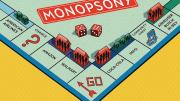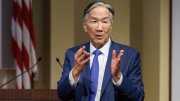Market concentration, the economist’s term for how much an industry is dominated by one or a few firms, touches ever more aspects of American life. From the obvious (the Amazons and Walmarts of the retail economy) to the obscure (the beer industry, which may appear diverse, is dominated by two firms), market concentration has increased in three-quarters of U.S. industries during the twenty-first century. This has had wide-ranging effects not only on consumers, but also, economists increasingly believe, on labor. “Fewer firms in a given industry makes it easier for them to have more bargaining power [over employees], and harder for workers to switch to another employer,” says Jason Furman, professor of the practice of economic policy at the Harvard Kennedy School, and former chair of the Obama administration’s Council of Economic Advisers.
Today’s labor markets increasingly look like a monopsony: a market in which there is only one buyer—the inverse of a monopoly, in which there is only one seller. The more an industry is dominated by a small number of corporations, the more those companies can control the cost of labor. Traditionally, Furman says, economists have relied on a supply-and-demand story about the labor market: “There’s a supply of workers and demand for workers, and the wage is what clears the market, just like the price of wheat is what clears the market for wheat. That explains a lot about wages, but it probably doesn’t explain everything…[T]hat research program went as far as it could.”
In the last three years, Furman explains, economists have looked to monopsony and other factors beyond market competition to explain the stagnation of Americans’ wages during the last few decades. Fewer companies in a given industry make it easier for those companies to coordinate, either indirectly or through overt collusion, to keep wages low. Think of a town with two big-box retail stores: each store knows what the other pays its cashiers, and neither wants to raise wages. Firms can also use noncompete agreements, which ban employees from taking jobs at rival companies, to prevent workers from finding new jobs elsewhere. About 24.5 percent of the American work force has signed a noncompete, according to one Brookings Institution analysis, and this number is not much lower (about 21 percent) for workers earning less than the median salary.
Because it isn’t possible to show causation in studies of a big, aggregate phenomenon such as the effect of monopsony across the U.S. economy, evidence in this line of research “comes sort of like a collage of different pieces here and there, none of which are a randomized experiment or mathematical proof,” Furman explains. Some papers examine case studies of growing concentration in industrial sectors like beer or fertilizer; others zoom out to look at the economy as a whole. One 2017 study coauthored by Allison professor of economics Lawrence Katz found, for example, that the share of national income going to labor has fallen in tandem with the rise of “superstar” firms: situations where a small number of companies gain a very large share of an industry. The share of income going to labor fell the most in industries where concentration has increased the most.
Why monopsony has prevailed across so many industries isn’t completely understood, but it is probably due partly to technological changes that make it easier for companies like Amazon to dominate the retail sector. Federal antitrust enforcement, conceived as a way to protect consumers rather than workers, is also not as robust as it once was, permitting ever-larger corporate mergers. And once firms control an industry, they may hinder new competitors by such means as patents or regulatory barriers: opening a new hospital, for example, often requires a “certificate of need” showing that the community needs it. “The theory was: there was overbuilding and too many hospitals driving up costs,” Furman says. “That theory seems to be less persuasive than the theory that what’s driving up prices is too little competition.…That too much competition would be bad is something that people who don’t want competition came up with.”
Another, subtler reason that monopsony might affect wage growth: the gigification of the economy. Much has been written, in this magazine and elsewhere, about the rise of contract work like driving for Uber and outsourced custodial jobs (though research on the extent of the gig economy is young and still contested). Precarious by design, and lacking the benefits and protections afforded W-2 workers, gig work has contributed to the erosion of the American middle class in the last two decades. But an indirect consequence of the gig economy is its effect on traditional employees: it may reduce the bargaining power of workers in general, and makes a bad deal at a full-time job look better than unstable contract work at, in effect, a sub-minimum wage.
Furman and others have recommended a slate of policy ideas to restrain the influence of monopsonies, and help make labor markets freer and more competitive. Princeton economist Alan Krueger, Ph.D. ’87, has proposed strengthening antitrust enforcement to make mergers more difficult, and banning noncompete agreements for low-income workers, as some states have already done. These new approaches ought to augment traditional interventions that economists already know can work, Furman says, including raising the minimum wage and making it easier for workers to unionize. But the new insight of recent research on market concentration, he believes, has been that it’s not simply the rules governing the labor market that affect wages, it’s also those governing product markets—making market concentration a concern to Americans not only as consumers, but also as workers and citizens.









